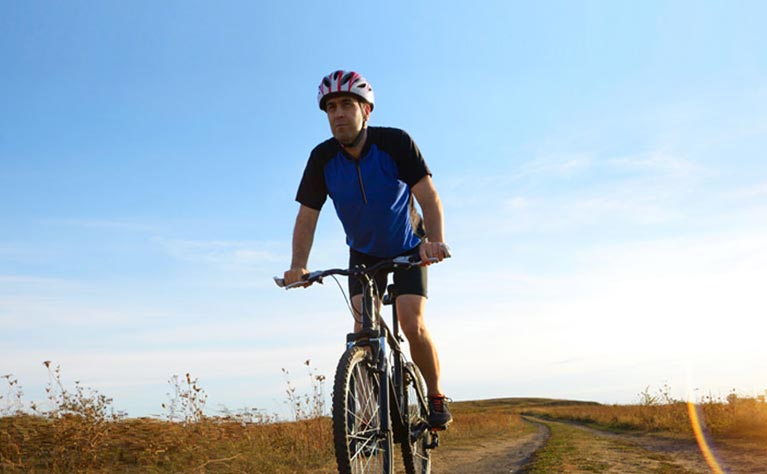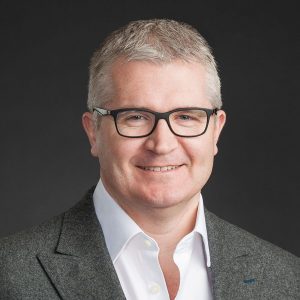Martin is back to biking, skiing and hiking after a high tibial osteotomy and a ChondroGide patch to repair damaged joint cartilage
Martin is an extremely active 45-year-old who had been experiencing knee pain when running for some time when he sought treatment. The pain had begun to interfere with his sleep and he had started to limp.

I would definitely recommend the surgery, but be prepared to put in the hours with the physio and make sure you get a GameReady and use it for the first two weeks (ideally all the time) – it really helped minimise the swelling and accelerated my recovery.
TAGGED INProf Adrian Wilson
Knee osteotomy (realignment) surgery
The London Knee Osteotomy Centre
Constant knee pain and even a limp was preventing Martin from pursuing the many sports and activities he enjoys.
He was sent a list of surgeons by his insurance company, but was unsure about how to select the right consultant for him. Initial online research was also inconclusive, so Martin resorted to searching for ‘Best knee surgeons in the UK’ and found Professor Wilson.
Martin says: “Reassuringly, in the run up to and post-surgery, speaking to nurses and physios they all said he was the best….”
After an initial consultation, Adrian reviewed Martin’s MRI scan, which showed a large defect in his cartilage and also indicated that Martin’s leg was out of alignment, causing more wear on one side of his knee.
Adrian recommended a high tibial osteotomy to realign Martin’s leg. This operation wedges open the upper shin bone (tibia) to reconfigure the knee joint. The weight-bearing part of the knee is shifted from degenerative or worn tissue onto healthier tissue. A cartilage patch was applied at the same time to deal with the defect in the cartilage in Martin’s knee.
Adrian explains: “This cartilage patch technology has been around for a good ten years – perhaps even longer – and what we do is a very tidy microfracture, or nanofracture to the bone once we have prepared the joint surface, and then we lay the patch which is made of naturally occurring collagen and has a very unique bi-layer structure. The technique is called AMIC – Autologous Matrix-Induced Chondrogenesis – and it is ‘single step’. The cartilage patch or collagen matrix is laid over the top and this acts as a tarpaulin over the top of the nanofracture or microfracture that we carry out, and it keeps the stem cells that come out of the patient’s bone in a contained fashion.”
Martin was understandably nervous about having these procedures and the effect they would have on his running. His best hope prior to the operation was to be able to ski again, but he thought running would be out of the question.
Martin’s surgery went well and his recovery was spectacular. He left hospital within a day or two and was pain-free pretty much from that point.
Adrian says: “I think that is testament to the new technique that we have been able to develop with the new osteotomy techniques that I have been fortunate to help to bring in.”
Although the initial 3 to 4 weeks post operation were a challenge (lots of physio and being non weight bearing), Martin recovered at a remarkably quick rate. He was back home working after 1 week and was back driving after 8 weeks but most importantly I was walking without pain and discomfort.
Since the surgery Martin’s expectations have been surpassed, although he has decided to stop running to protect the work that was done. However, he can now play football again with his children and run around on the beach on holiday, which he couldn’t do prior to the procedure.
He says: “Now I am out on my mountain bike a few times each week, regular Pilates classes and busy in the garden back to cricket coaching and playing, and back to trekking in the Lake District with my brother – oh, and I did get back skiing after 5 months (although I did take it easily to start with!)”
His recommendation to others with similar problems: “I would definitely recommend the surgery, but be prepared to put in the hours with the physio and make sure you get a GameReady and use it for the first two weeks (ideally all the time) – it really helped minimise the swelling and accelerated my recovery.”
Martin summarises: “It all massively surpassed my own expectations and I am enjoying a very active life again!”
Adrian concludes: “It is a great story of using modern techniques such as AMIC together with osteotomy to get a truly great result.”

Looking to speak to our team? Call us on 020 7046 8000 020 7046 8085
To book an appointment
or refer a patient
